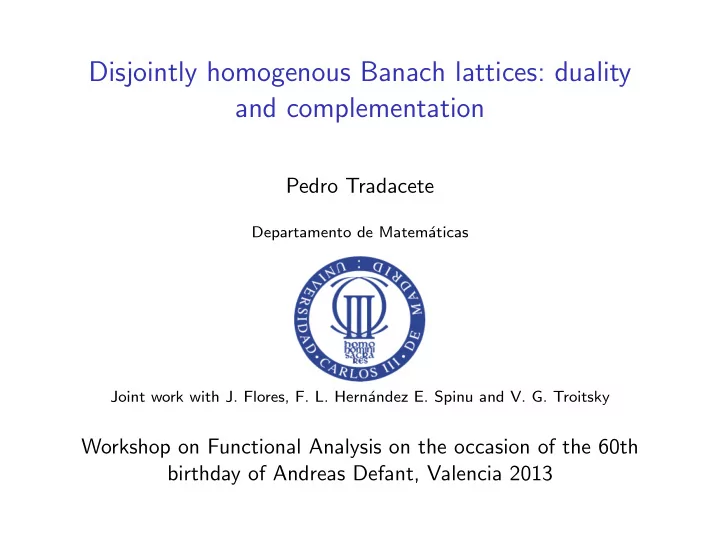

Disjointly homogenous Banach lattices: duality and complementation Pedro Tradacete Departamento de Matem´ aticas Joint work with J. Flores, F. L. Hern´ andez E. Spinu and V. G. Troitsky Workshop on Functional Analysis on the occasion of the 60th birthday of Andreas Defant, Valencia 2013
Disjointly homogeneous Banach lattices: Definition E is disjointly homogeneous (DH) ⇔ ∀ ( x n ), ( y n ) disjoint in E , ∃ ( n k ) such that ∞ ∞ � � ∼ � � � � � a k x n k a k y n k � � � k =1 k =1 Examples: L p , L p , q , Λ( W , p ), ℓ p ( X n ) . . . Definition E is p -disjointly homogeneous ( p -DH) if every disjoint sequence ( x n ) in E has a subsequence such that ∞ � ∞ | a k | p � 1 / p ( sup � � ∼ � � � a k x n k | a k | in case p = ∞ ) � k k =1 k =1 Remark: Not every DH Banach lattice is p -DH (Ex. Tsirelson)
Applications of DH Banach lattices Theorem E DH with finite cotype and unconditional basis. T ∈ SS ( E ) ⇒ T 2 ∈ K ( E ) Theorem E 1-DH with finite cotype. T ∈ SS ( E ) ⇒ T ∈ DP ( E ) Theorem E 2-DH with finite cotype. T ∈ SS ( E ) ⇒ T ∈ K ( E ) Theorem E discrete with a disjoint basis and DH. T ∈ SS ( E ) ⇒ T ∈ K ( E )
Duality Question: Is the property DH stable by duality? Known-facts: ◮ E ∞ -DH ⇒ E ∗ 1-DH. ◮ L p , 1 is 1-DH but L ∗ p , 1 = L p ′ , ∞ is not DH. ◮ Maybe for E reflexive? We will show that in general the answer is negative (even in the reflexive case), but will also provide positive results.
Positive results Definition A Banach lattice E has property P if for every disjoint positive normalized sequence ( f n ) ⊂ E there exists a positive operator T : E → [ f n ], such that � T ∗ f ∗ n � � 0. Theorem Let E be a reflexive Banach lattice with property P . If E ∗ is DH, then E is DH. Moreover, in the particular case when E ∗ is p-DH, for some 1 < p < ∞ , then E is q-DH with 1 p + 1 q = 1 . Corollary Let E be a reflexive Banach lattice satisfying an upper p-estimate. If E ∗ is q-DH (with 1 p + 1 q = 1 ), then E is p-DH.
Orlicz spaces Theorem ∼ = { t p } . Here, E ∞ An Orlicz space L ϕ (0 , 1) is p-DH ⇔ E ∞ = ϕ ϕ � ϕ ( rt ) t ϕ ′ ( t ) � � ϕ ( r ) : r ≥ s . In particular, this holds if l´ ım ϕ ( t ) = p. s > 0 t →∞ ϕ (0 , 1) is q -DH ( 1 p + 1 Remark: L ϕ (0 , 1) is p -DH ⇔ L ∗ q = 1). Theorem A separable Orlicz space L ϕ (0 , ∞ ) is p-DH (for 1 ≤ p < ∞ ) if and only if C ϕ (0 , ∞ ) ∼ = { t p } . Where C ϕ (0 , ∞ ) = conv { F ∈ C (0 , 1) | F ( · ) = ϕ ( s · ) ϕ ( s ) , for some s ∈ (0 , ∞ ) } . Example Let 1 < p < ∞ and an Orlicz function ϕ ( t ) agrees with t p on [0 , 1] and ϕ ( t ) ≃ t p log(1+ t ) on [1 , ∞ ). Then the Orlicz space L ϕ (0 , ∞ ) is a reflexive p -DH Banach lattice whose dual is not DH.
Projections onto disjoint sequences Question: Does every reflexive Banach lattice contain a complemented positive disjoint sequence? Theorem Let E be a DH Banach lattice. E has property P if and only if E contains a complemented positive disjoint sequence. Theorem If E is a separable non-reflexive DH Banach lattice, then every dis- joint sequence in E has a subsequence spanning a complemented subspace in E. Theorem Let E be a p-DH Banach lattice which is p-convex with 1 < p < ∞ . Then every disjoint sequence in E has a subsequence spanning a complemented subspace in E.
References J. Flores, F. L. Hern´ andez, E. M. Semenov and P. Tradacete , Strictly singular and power-compact operators on Banach lattices . Israel J. Math. 188 (2012), 323–352. J. Flores, F. L. Hern´ andez, E. Spinu, P. Tradacete and V. G. Troitsky , Disjointly homogeneous Banach lattices: duality and complementation . (preprint available at http://gama.uc3m.es/images/gama_papers/ptradace/ dh_duality.pdf ). J. Flores, P. Tradacete and V. G. Troitsky , Disjointly homogeneous Banach latices and compact product of operators . J. Math. Anal. Appl. 354 (2009), 657–663.
Thank you all for your attention... and Happy Birthday Prof. Defant
Recommend
More recommend